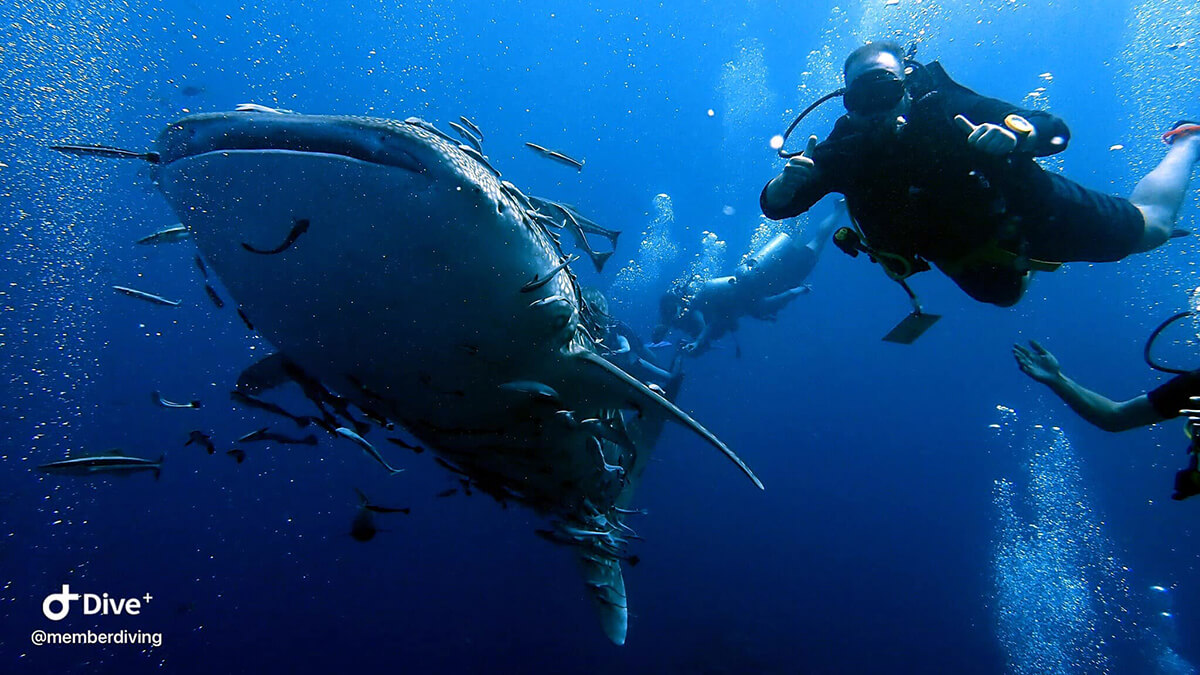Whale shark yesterday – whale shark today. And when are you coming to visit him?
The whale shark (Rhincodon typus) is the largest shark and also the largest fish of the present day. It is the only species of the genus Rhincodon, which in turn is the only genus within the family Rhincodontidae. The whale shark belongs to the order of nurse sharks. The animals inhabit tropical to subtropical seas and are found both near and far from the coast. Like basking sharks and basking sharks, they feed on plankton and other microorganisms (krill), which they filter by sucking in the water.
Characteristics of the whale shark
According to studies of 317 individuals off Belize, the whale shark grows between 3.0 and 12.7 m long with an average of 6.3 m. For 360 other individuals on Ningaloo Reef off the coast of Western Australia, predominantly males, sizes of 4.0 to 12.0 m and averages of 7.6 m are given. One specimen stranded on the coast of India reached a length of 13.7 m, while another caught off India is said to have been 14.5 m long. Individual reports have also indicated that specimens up to 18 m long have been observed. A ten-year study on the Ningaloo Reef allowed to study the growth development of whale sharks. According to this study, males increase rapidly in body size at the beginning, but then the growth curve flattens out. Adult males reach maximum lengths of 8 to 9 metres. Females, on the other hand, grow more slowly and steadily and are calculated to grow up to 14.5 m in length. The weight may be over 12 t.
Whale sharks are greyish, brownish or bluish in colour. The belly is brightly coloured, the back is covered with bright stripes and spots arranged in transverse lines. The large mouth extends across the entire width of the flattened and blunt snout. The whale shark is the only representative of sharks with a terminal mouth. The approximately 3600 small teeth are arranged in more than 300 dense rows. The animals have five gill slits, two dorsal fins as well as pectoral and anal fins. The upper lobe of the caudal fin is about a third longer than the lower. With a thickness of up to 15 cm, its skin is the thickest of all living creatures on earth.
Distribution and habit of the whale shark
Whale sharks prefer a water temperature of 21 to 25 °C and are found in almost all warm, tropical and subtropical waters worldwide, although there are regions where they occur more frequently. These are usually areas with seasonal plankton blooms or regions where plankton-rich colder upwelling waters are observed. Whale sharks frequently migrate between nearshore and offshore areas. Males travel considerable distances, females only shorter ones; they seem to return regularly to the area of their birth. Male sharks also return to specific sites time and again. Whale sharks occur singly, but also in groups. Such gatherings have been observed with over 400 individuals in one particular area off the coast of the Yucatán Peninsula, in which case the animals feed mainly on large aggregations of tuna spawn. This is the largest aggregation of whale sharks ever sighted and it apparently occurs seasonally.
Walhaie saugen das Wasser aktiv an (bis zu 6000 l/h) und pressen es durch ihre Kiemen wieder aus, die mit einem schwammartigen Filtrierapparat versehen sind. Dieser wird aus Knorpelspangen gebildet, welche die einzelnen Kiemenbögen wie ein Gitter miteinander verbinden und auf denen untereinander verfilzte Hautzähnchen sitzen. Um ihren enormen Nahrungsbedarf zu decken, filtern sie auf diese Weise neben Plankton auch kleine Fische und andere Meeresbewohner, etwa Tintenfische, aus dem Wasser. Häufig „stehen“ sie dabei senkrecht, den Kopf zur Wasseroberfläche gerichtet im Wasser, oder sie bewegen den aus dem Wasser ragenden Kopf von einer Seite zur anderen und öffnen und schließen dabei das Maul (7–28 Mal pro Minute).
Growth and reproduction
The discovery of an egg measuring approximately 30 × 14 × 9 cm with a 36 cm whale shark embryo in 1953 in the Gulf of Mexico seemed to confirm the earlier assumption that whale sharks were egg-laying sharks. Only the capture of a pregnant female off Taiwan in 1995 and the scientific examination of this specimen revealed that whale sharks can give birth to up to 300 live young. However, these young are not all at the same stage of development, as is the case with many other shark species. Rather, different young and older embryonic developmental forms are present in parallel. The more developed they are, the closer the young are to the natal opening. It is likely that the female can control the development and thus the birth over many years and only gives birth when she considers the chances of survival of her young to be high. This is probably closely related to the food supply, the currents and the temperatures of the water. These assumptions have not yet been sufficiently proven, but they are the most likely explanation for this peculiarity. The egg found was probably a prematurely lost one.[1] Usually the sharks hatch already in the womb with a size of 58 to 64 cm. The smallest specimen found had a length of about 40 cm and was found in shallow waters near the coastal town of Donsol in the Philippine province of Sorsogon. It is possible that the sea area near Donsol is a breeding ground for whale sharks.
It can only be speculated where the young complete their further development to sexual maturity after birth. It is likely that they develop at greater depths. Possibly below a depth of 300 metres, as they could still be food competitors for their adult conspecifics above this depth. This would be rather disadvantageous for young and old. Possibly they advance into deeper water layers that their parents cannot reach.
The whale shark does not reproduce until it is between 10 and 30 years old and can live up to 100 years.
Want to see the whale shark too? Sign up for the diving adventure today!








